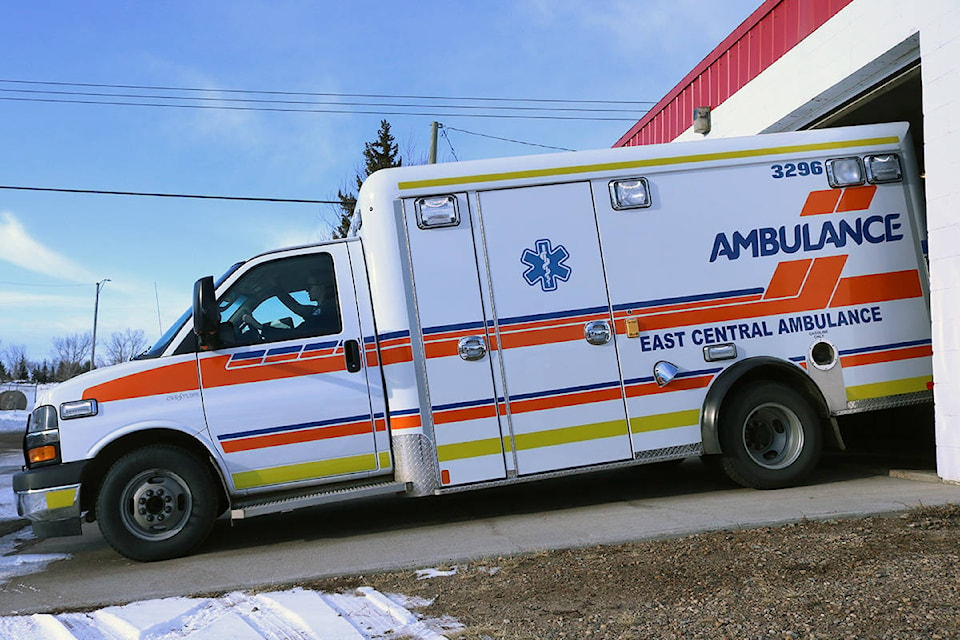By Kevin J. Sabo
For the Advance
East Central Ambulance Association is the contracted service provider for Emergency Medical Services in the region.
In part one of this series, we explored the different levels of ambulance service in the province, as well as how East Central Ambulance Association fits in with the bigger picture under Alberta Health Services.
Part two is going to look more deeply at the similarities and differences between a contracted ambulance versus an Alberta Health Services Ambulance.
“ECAA is separate from AHS, but contracted to AHS,” said ambulance Supervisor Kyle McQuade.
“We provide the same care as AHS. Our behind-the-scenes is different.”
As a contracted ambulance service provider, there are a number of steps put in place to maintain standards.
All ambulance practitioners, regardless of whether they work for a contracted service or for Alberta Health Services all work under the same province-wide protocols.
In addition, all services in the province, including Alberta Health Services, are required to be accredited by Accreditation Canada, an outside service healthcare accreditation service.
When the requirement for the accreditation came in, East Central Ambulance was the first contracted service in the province to receive their two year ‘Primer Accreditation’ status.
In addition to the protocols and the accreditation requirements, the Alberta College of Paramedics, the governing body of EMS professionals in the province, mandate that all practitioners receive 60 credits worth of training every year. Thirty credits need to be from structured sources; however, 30 can also be acquired through the use of in-service training, something that McQuade, as unit training officer, attempts to do on at least a monthly basis with the staff.
“It’s not terrible, but does get pricey,” said McQuade, talking about the structured training.
As for the in-house training, McQuade works on keeping the training relevant to what the staff need, and this is done through the auditing of Patient Care Reports.
“They can be reviewed the second the call is done,” McQuade said.
“We can do a lot more feedback to the practitioner. We can review the call with them protocol-wise, so we’re not playing catch-up.”
Unlike Alberta Health Services, East Central Ambulance audits 100 per cent of the calls that get run by the crews. Alberta Health Services doesn’t audit anywhere near that many.
“It’s tedious, it’s something we put in place when we did a lot fewer calls,” said McQuade.
The audits done on a Patient Care Report vary depending on the type of call. A typical, routine transfer could take a minute or two to run through, where an emergency call could a longer, more thorough look.
“Six or seven hours can get us through the majority of the month (of calls),” said McQuade.
What aids the audit process is the fact that everything is done by computer aided dispatch. Through a Mobile Data Terminal in the ambulance, the crews receive their call information from dispatch, they can mark themselves on-route, on scene, etc. and the tablet that is used for taking patient information is directly linked to the terminal as well, so the patient care records get uploaded immediately through an encrypted signal.
Especially in light of the ever-increasing call volumes, there is not much typical about a shift.
The crews working for East Central Ambulance Association work a four-day on, four-day off rotation, on call during the entire time, though limits have been put in place if they catch a particularly busy tour.
When a crew comes on shift, they will sign into the Mobile Data Terminal in the ambulance with their Alberta College of Paramedics registration number, then do the mechanical and equipment checks on the ambulance.
When not running calls, the crew members have their projects that they work on.
McQuade and a few others audit the Patient Care Records, someone else will look after inventory in the base, and so on. What’s kept an experienced hand like McQuade at the ambulance for so long? He attributes that to the health care team he works with.
“I like being part of a smaller health care team,” said McQuade.
“We can hand over care within five minutes (of arrival at the hospital).”
His partner Primary Care Paramedic Karli Plenhert, agrees, adding that in addition to handing over care to the hospital, frequently the ambulance crews are able to continue helping after care has been turned over.
“I feel you can do more out here,” she said.
